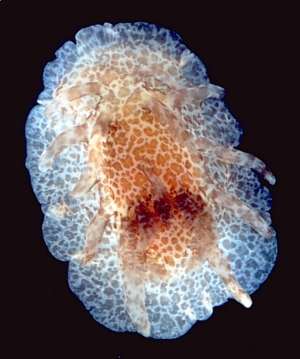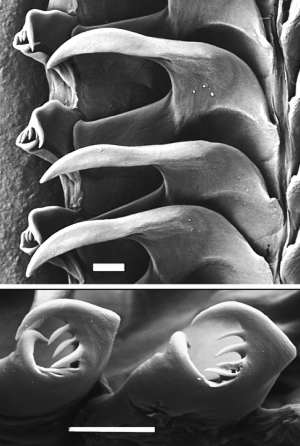

Okenia plana
Baba, 1960
Order: NUDIBRANCHIA
Suborder: DORIDINA
Superfamily: ANADORIDOIDEA
Family: Goniodorididae
DISTRIBUTION
This species has a wide distribution in the western Pacific being reported from Japan, Hong Kong, New Zealand, Australia and recently from the Philippines (Gosliner, 2004). Its presence also in California (Gosliner, 2004) is considered an artificial distribution brought about the fouling bryozoans it feeds on being transported long distances by shipping.
PHOTO
Upper: Five Dock Point, Drummoyne, Sydney, New South Wales, Australia, May 1984, 10 mm long, AM C142137. Photo: W.B. Rudman. Lower: SEM of radula showing some teeth on left side (upper) and close-up (lower) of outer teeth. Mirs Bay, Hong Kong, 5–12m, 11 April 1983, AM C139053. Scale bars = 10 µm. Photo: G. Avern.
NOTE: Previously known on the Forum as Hopkinsia plana.
Animal ranges in shape from almost circular, to broadly ovate, and has a low flattened profile. From above, the mantle, foot and head merge into one. There is a raised visceral hump in the midline, which is outlined by the 5 elongate lateral mantle papilla down each side. The foot extends out all around the body as a thin layer, hugging the contours of the substrate. There is a single medio-dorsal papilla midway between the gills and the rhinophores, and the 12 or so gills form a circle in the posterior midline around the anus. Ventrally a slight groove can be seen differentiating the head from the anterior foot, but there is no sign of oral tentacles.
The general colour of specimens from Australia and New Zealand is translucent white with closely packed relatively large brown patches, the spaces between the brown patches creating a network of whitish lines. On closer examination, each brown patch is edged with a thin opaque white line. Sometimes the white lines of adjacent brown patches merge, and in other cases they are separated by a translucent whitish region. In some specimens the opaque white pigment is absent, or there is only traces of it here and there. In these animals the network pattern between the brown patches is basically translucent white or straw coloured. The mantle papillae, the rhinophores, and the gills all have the same colour pattern, making the animals very cryptic when sitting on its bryozoan food. Specimens from Japan & Hong Kong (Rudman & Darvell, 1990) have traces of the opaque white lines that outline each large brown patch in Australian specimens, but instead of having a large brown patch, Hong Kong specimens have a small dark brown spot in the centre of the space. The general affect then is of a white reticulate pattern on a translucent background with a small dark brown spot in the centre of each 'mesh'
The radula is fairly typical of the Goniodorididae but it has its special characteristics. The innermost tooth has a broad base and a long elongate pointed cusp, but there is no sign of denticles along the cutting edge. The much smaller outer teeth have a broad quadrangular base with a large recurved pointed cusp at the tip, below which are 2 or 3 smaller secondary cusps, and then a basal cusp similar in size to the uppermost.
Okenia plana is very similar to O. pilosa in shape and colour but differs in having only a few long rounded lateral papillae on the mantle. I have suggested (Rudman, 1995) that the earliest name for this species is Doris eolida Quoy & Gaimard, 1832, which was proposed for a small 5mm animal found clinging to floating Sargassum weed in the South China Sea. This name does not affect the nomenclatural status of Okenia plana because there is no way to ever prove just what Doris eolida was as the specimens are lost. Okenia plana lives and feeds on encrusting bryozoans which commonly foul man-made objects such as wharf piles, ship's bottoms, and algae. They have usually been identified as Membranipora membranacea (Linnaeus, 1767), but Dr Dennis Gordon has recently identified two other cosmopolitan cheilostome bryozoans, Cryptosula pallasiana (Moll, 1803), a fouling organism on wharf piles and algae, and Jellyella tuberculata (Bosc, 1802), which is usually found on attached and floating brown algae from food samples I have sent him from New South Wales.
-
Baba, K. (1960). The genera Okenia, Goniodoridella, and Goniodoris from Japan (Nudibranchia: Goniodorididae). Publications of the Seto Marine Biological Laboratory, 8: 71-74
-
Rudman, W.B. & Darvell, B.W. (1990) Opisthobranch molluscs of Hong Kong. Part 1. Goniodorididae, Onchidorididae, Triophidae, Gymnodorididae, Chromodorididae, (Nudibranchia). Asian
Marine Biology, 7, 31–79. -
Rudman, W.B. (1995) The Chromodorididae (Opisthobranchia: Mollusca) of the Indo-West Pacific: further species from New Caledonia and the Noumea romeri colour group. Molluscan Research, 16, 1–43.
-
Gosliner, T. M. (2004) Phylogenetic Systematics of Okenia, Sakishimaia, Hopkinsiella and Hopkinsia (Nudibranchia: Goniodorididae) with descriptions of new species from the tropical Indo-Pacific. Proceedings of the California Academy of Sciences, 55: 125-161.
-
Rudman, W.B. (2004) Further species of the opisthobranch genus Okenia (Nudibranchia: Goniodorididae) from the Indo-West Pacific. Zootaxa, 695: 1-70.
ARCHIVE NOTE: An earlier edition of this Fact Sheet [3 August 1998] as Hopkinsia plana is available on request.
Authorship detailsRudman, W.B., 2004 (December 21) Okenia plana Baba, 1960. [In] Sea Slug Forum. Australian Museum, Sydney. Available from http://www.seaslugforum.net/find/hopkplan
Related messages
Hopkinsia plana from Hong Kong
February 4, 2002
From: Bill Rudman & Brian Darvell


Here is some information and photos on Hopkinsia plana from Brian Darvell's Hong Kong collections.
Very similar to Hopkinsia pilosa in shape and colour but differs in having only a few long rounded papillae on the mantle. There is usually one in the middle of the back and about five down each side near the mantle edge. In Japanese and Hong Kong specimens there are small brown specks all over the mantle and body but in Australia and New Zealand there are much larger brown patches. Hopkinsia plana is reported to feed on the colonial bryozoan Membranipora membranacea, a common fouling organism on wharf piles, and algae. Specimens from Hong Kong, 10 mm long preserved, have been found on an as yet unidentified bryozoan.
PHOTO:
AM C150268, 5 April 1986, Site 5.128, Heung Lo Po (E), Tolo Channel, 1 m . Photos: Brian Darvell.
Hong Kong Collection Records:
AM C150268, 5 April 1986, Site 5.128, Heung Lo Po (E), Tolo Channel, 1 m (prey only). AM C138144, 20 February 1983, Site 14.41, Tai Tam Harbour, Hong Kong Is., 1 m. AM C139053, 19 specimens, 11 April 1983, Site 4.59, Gau Tau (N), Mirs Bay, 5-12 m. AM C139054, 12 April 1983, Site 2.61, Bluff Head, Tolo Channel, 4-7 m. AM C139055, 6 specimens, 14 April 1983, Site 2.32, Round Is. (E), Mirs Bay, 3-10 m. AM C141489, 5 specimens, 25 February 1984, Site 10.99, Kiu Tau (W), Kiu Tsui Chau, Port Shelter, 4-7 m. Depth range: 0.5-12 m.
Reference:
• Rudman, W.B. & Darvell, B.W. (1990) Opisthobranch molluscs of Hong Kong. Part 1. Goniodorididae, Onchidorididae, Triophidae, Gymnodorididae, Chromodorididae, (Nudibranchia). Asian Marine Biology, 7: 31-79
Best wishes,
Bill Rudman & Brian Darvell
Feeding in Hopkinsia plana
August 3, 1998
From: Bill Rudman

In Andy Cohen's message on Okenia zoobotryon he mentions Hopkinsia plana living on the encrusting bryozoan Conopeum. I don't think Hopkinsia plana is quite so food specific as some species. Here are two photos of it on different species of bryozoan in New South Wales.
UPPER PHOTO: Woolgoolga, northern NSW, Australia, November 1982, on Membranipora, an encrusting bryozoan often found on laminarian algae.
LOWER PHOTO: Drummoyne,Sydney Harbour, under intertidal rocks, NSW, May 1984, on unidentified bryozoan.
PHOTOS: Bill Rudman.
If my suggestion that Quoy & Gaimard's record of this species as Doris eolida is correct, then this species can drift in the open ocean on floating laminarian algae... Bill Rudman
Rudman, W.B., 1998 (Aug 3). Comment on Feeding in Hopkinsia plana by Bill Rudman. [Message in] Sea Slug Forum. Australian Museum, Sydney. Available from http://www.seaslugforum.net/find/185